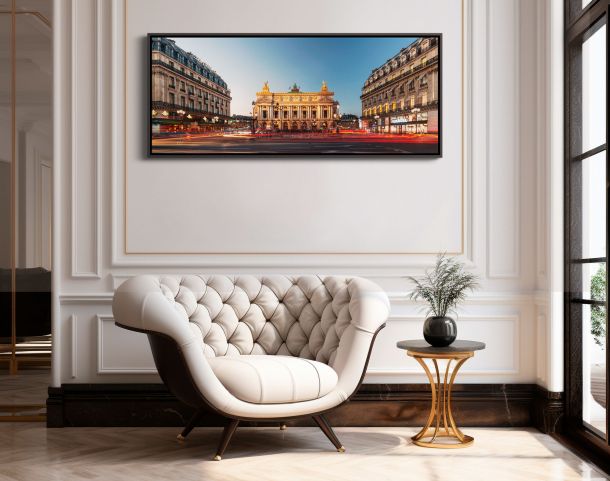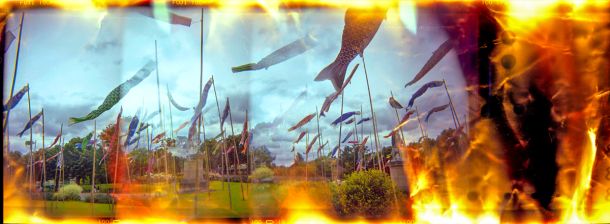Biophilic Design: Nature, Art, and Well-being

Water drops – Photo : © Sebastien Desnoulez
Do you sometimes feel disconnected from nature?
Biophilic design subtly integrates art, photography, and natural elements to bring your spaces back to life by recreating a fundamental connection with the outside world. Discover how this innovative approach transforms your daily environment into a calming place, where well-being and aesthetics come together through the evocative power of nature captured in images.
Summary
- Foundations of biophilic design and its link with nature
- Photography as an element of biophilic design
- Art as an expression of biophilic principles
- Practical integration in various environments
Foundations of biophilic design and its link with nature
Definition and origins of the biophilic concept
Biophilic design is an approach that integrates natural elements into built environments to reinforce the human connection with nature.
The concept of biophilia was developed by Edward O. Wilson in the 1980s, based on the idea of an innate need to connect with living systems. Stephen Kellert formalized its principles into nineteen categories, incorporating natural light, vegetation, and organic materials. This approach evolved as a response to increasing urbanization, integrating nature into modern architecture.
Core principles of biophilic design
Natural elements such as daylight, plants, and raw materials are central to biophilic design. These components create a calming environment that enhances well-being and productivity in indoor spaces.
| Pattern | Category | Application Example |
|---|---|---|
| Living plants | Nature in the space | Green walls in offices or vertical gardens in lobbies |
| Moving water | Nature in the space | Wall fountains or indoor ponds creating soothing sounds |
| Natural light | Nature in the space | Large windows and skylights in residential areas |
| Natural materials | Natural analogues | Use of raw wood and stone in reception furniture |
| Organic shapes | Natural analogues | Sofas with flowing lines imitating sand dune curves |
| Biomorphic patterns | Natural analogues | Wall art inspired by cellular structures or root systems |
| Organization and order | Nature of the space | Landscaping balancing geometric structures and natural growth |
| Refuge and prospect | Nature of the space | Green partitions creating intimate areas with open views |
Biophilic design differs from sustainable design by focusing on the human-nature connection, whereas sustainable design mainly aims to reduce environmental impact. Both approaches can complement each other by using sustainable materials within a biophilic framework.
Health and well-being benefits
Biophilic design enhances well-being by reducing stress and boosting focus. It promotes relaxation and strengthens immunity through exposure to natural elements in living spaces.
Studies show that biophilic spaces increase productivity by 15 to 20% and improve concentration. Both objective (performance, output) and subjective (satisfaction, well-being) measures reveal positive effects on mental and physical health.
Photography as an element of biophilic design
The role of photography in biophilic design
Nature photography plays a key role by bringing the visual and emotional benefits of nature into indoor spaces where direct access is limited.
Nature photographs can enhance the biophilic impact of a space by evoking positive emotions and reducing stress. They adapt to the function of each space:
- Soothing landscapes (forests, mountains) for relaxation areas
- Dynamic wildlife photos to boost creativity in professional settings
- Sunsets or ocean views for bedrooms
- Photographs of sunlight filtering through leaves for a vibrant ambiance
- Images of flowing streams to evoke natural rhythm
Images of natural scenes activate the same brain areas as real nature, lowering cortisol and promoting relaxation. Some photos, such as dense forests or waterfalls, are more calming due to their visual complexity balanced by harmonious organic shapes.
Integrating photography into various spaces
Contemporary architectural photography offers a modern way to integrate natural motifs into living rooms or offices, blending geometry and nature in a harmonious balance.
To maximize biophilic impact, combine various formats and scales to create visual rhythm. Wooden or rattan frames enhance authenticity. In office settings, prefer forest landscapes or flowing water scenes to boost focus and reduce mental fatigue among employees.
Case studies of biophilic photography projects
Projects like Amazon’s Seattle headquarters have included large-scale rainforest photography in workspaces, creating visual continuity with the live plants on site.
Biophilic photographers use formal simplicity in care settings, with filtered light images through leaves. In schools, macro photos of natural microcosms (water drops on petals) stimulate curiosity while creating a calm learning atmosphere.
Art as an expression of biophilic principles
Biophilic art: definition and features
Biophilic art expresses the connection between nature and artistic creation, fostering visual and emotional bonds with the natural environment through artworks and installations.
Organic forms, biomorphic patterns, and natural materials define this artistic approach. The artworks often include raw textures or living elements, transforming spaces into evocative places of serenity and harmony with nature.
Materials and techniques in biophilic art
Wood, cork, and linen are among the preferred materials for their authentic textures and low ecological impact in biophilic creations.
Artists explore bio-art with living organisms or land art techniques in natural environments. The Zaishui Art Museum exemplifies this approach with installations that directly incorporate the environment, such as artworks with fungi or aquatic ecosystems.
Contemporary artists inspired by biophilic design
Frank Lloyd Wright integrated nature into his architecture, such as Fallingwater, while contemporary artists explore interactions between living elements and architectural spaces.
- Meriadec Le Clainche uses steel and crystals to evoke organic shapes
- Olafur Eliasson integrates natural light and climate elements in his installations
Biomimicry inspires contemporary creations, with artworks reflecting patterns like the Fibonacci sequence or cellular structures, reinforcing the bond between art and nature.
Influence of the biophilic movement on artistic trends
Biophilic design redefines urban spaces by incorporating natural analogues, enhancing well-being through stress reduction and improved indoor air quality.
Current trends favor ephemeral outdoor artworks or interactive installations using light and water. This evolution is driving collaborations between artists and ecologists on low-carbon artistic projects.
Practical integration in various environments
Strategies for residential spaces
Incorporate biophilic photography and art into your home. Use images of landscapes, nature, or natural elements to reinforce your connection with the environment.
Choose raw materials and natural patterns for each room. The living room can host forest photographs, the bedroom aquatic scenes. Let natural light in to enhance the biophilic effect in your living spaces.
Applications in professional and public spaces
Biophilic art transforms offices by integrating visual natural elements. Fine art prints for professionals create calming environments that boost focus and reduce workplace stress.
ARP Astrance’s Living Platform illustrates biophilic integration in a professional space. Studies show that productivity rises by 15% in workplaces with natural elements. Public spaces like museums and schools also adopt this approach to enhance visitor experience.
Collaboration between designers, architects, and artists
Successful biophilic projects rely on synergy between professionals. Architects, designers, and artists combine their expertise to create harmonious environments.
| Profession | Contribution | Collaboration Tools |
|---|---|---|
| Architect | Structural integration of natural elements | Technical plans showing biophilic element locations |
| Designer | Selection of natural materials and textures | Color palettes and material samples |
| Artist | Creation of nature-inspired artworks | Photography, paintings, or biophilic installations |
To ensure success in a biophilic project, clearly define goals, involve all stakeholders early, and educate users on the benefits of this approach.
Integrating biophilic design into your spaces means choosing a more harmonious environment where nature inspires art. Photographs, natural materials, and organic forms work together for your well-being. Transform your interior into a sanctuary of serenity and creativity.
FAQ
What are the pitfalls of biophilic design?
Although beneficial, biophilic design presents challenges. Time constraints, technical difficulties, and budget are common obstacles. Moreover, noisy and polluted urban environments can limit the effectiveness of nature integration.
Successful biophilic concepts require careful planning. Architects and designers must overcome limitations, such as lack of natural light, to meaningfully and sustainably integrate nature.
How to measure the actual impact of biophilic design?
To assess the impact of biophilic design, it’s important to objectively measure its effects on occupants. This includes evaluating employee engagement and quality of life at work. Studies show that adding green plants and natural lighting can significantly improve overall well-being.
Creating pleasant spaces is key, but it’s equally important to measure the objective effects of these environments. In educational settings, for example, biophilic design can lead to notable improvements in learning abilities.
Biophilic design: what are the cost-effective alternatives?
There are many ways to incorporate biophilic design affordably. Favor the use of natural light, greenery, water, natural materials, as well as nature-inspired shapes and patterns. Budget-friendly options include tabletop fountains and mini aquariums.
Biophilic design has varied positive outcomes, from boosting sales in retail to improving workplace productivity. It can also enhance student learning, speed up recovery rates, and increase urban safety.
How to implement biophilic design in rental spaces?
Implementing biophilic design in rental spaces is possible through simple, removable elements such as potted plants, sheer curtains to enhance daylight, and accessories made of natural materials like wood or linen.
Use nature-inspired colors and patterns in cushions, art prints, or small decorative items. You can also play nature sounds or install a small indoor fountain to create a soothing and relaxing atmosphere.
How to choose and effectively integrate nature photography in a biophilic project?
Photography plays a key role in biophilic design by visually bringing nature into spaces where direct access is limited. Choose photographs captured with authentic techniques: natural light, detailed organic textures, and immersive perspectives.
Adapt your photo choices to the function of each space: soothing forest landscapes for relaxation areas, images of flowing water for offices, or sunsets to create a calm ambiance in bedrooms. Nature photography activates the same brain areas as direct observation of nature, effectively reducing stress and encouraging relaxation. For maximum impact, vary formats and use natural material frames.
What is the role of biophilic artificial lighting?
Biophilic artificial lighting aims to recreate natural light indoors, especially when access to daylight is limited. It is designed to mimic characteristics of daylight, such as brightness and color spectrum.
By simulating natural light, it helps reduce stress and boost mood, while potentially supporting indoor plant growth. This type of lighting is essential for human health and overall well-being.



